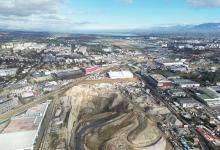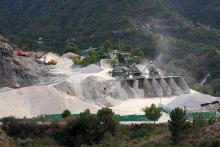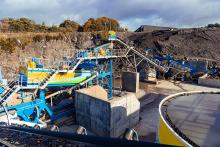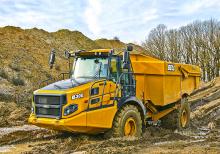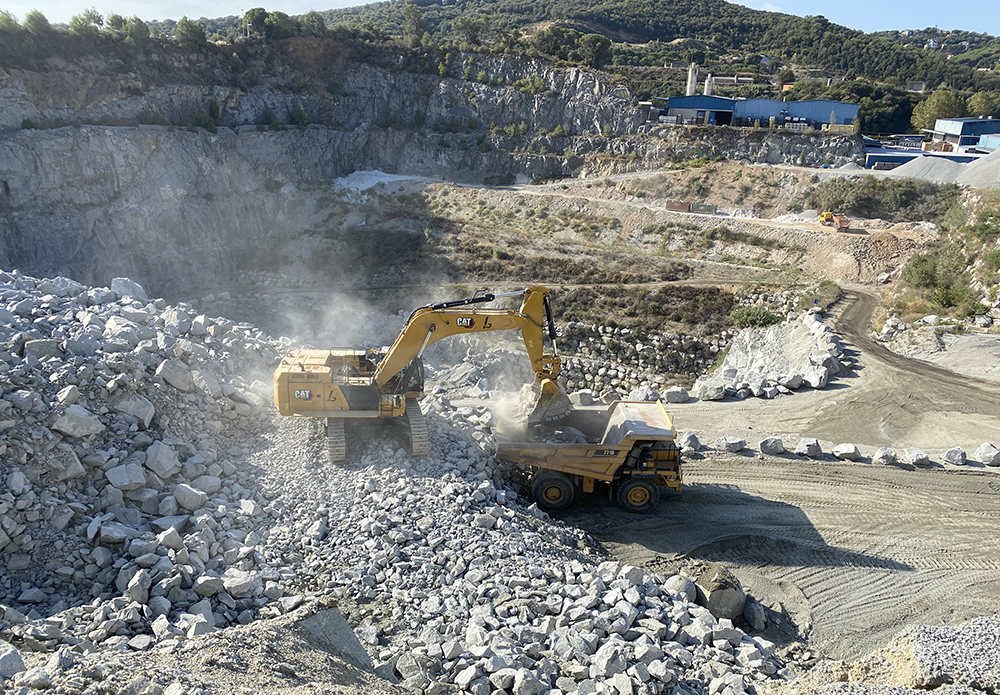
Situated near Barcelona in north-east Spain, the Àrids Garcia granite quarry has been in operation for more than six decades, and throughout this time has been one of Catalonia’s most modern granite aggregates extraction businesses.
The 30-hectare quarry site is located in Llinars del Vallès and produces a particularly hard form of granite, which requires the use of blasting explosives to remove the materials. Usually two to three blasts are carried out each month.
Francesc Garcia Alonso, the father of current company owners Jordi and Carlos Garcia, founded the Àrids Garcia business in 1962 together with his brothers. The father had been involved in materials-processing activity in the area since 1940 when he and his brothers started extracting sand by hand from the Besòs river, near what is now the Circuit de Barcelona-Catalunya motorsport race track.
Since the quarry was established it has continued to innovate and improve its equipment to supply major players in the surrounding North Catalonia region. It provides aggregates to large companies involved in the asphalt, concrete, prefabricated, and building sectors, which are a fundamental component of major works and projects in Catalonia.
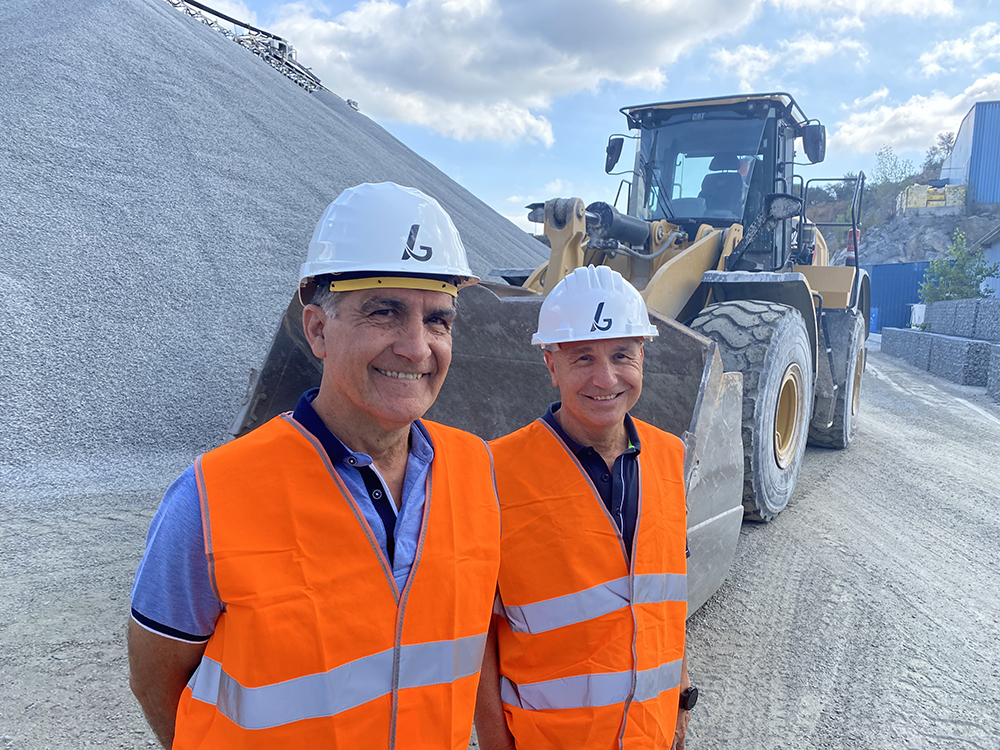
The company says its belief is that it is characterised by its impeccable service, the quality of its products, its high manufacturing capacity and the constant innovation and automation of its equipment and processes, adding that it always strives for excellence.
The quarry produces about 500,000 tonnes per year, with a maximum production capacity of 6,000 tonnes per day, of which 3,000 tonnes can be aggregates processed in the crushing and screening plant. It produces granite and its various sub-products such as sand.
The produced aggregates are suitable for use in the manufacture of asphalt agglomerates, to make concrete, for bases, and other building and gardening applications. In addition to construction companies, the quarry’s other two main customer segments are paving companies for its granite products, in addition to cement and concrete manufacturing plants. Blocks are also extracted for the building of land and sea breakwaters at ports, and some quarry products are used in railways for track ballast.
In terms of the end-to-end process of quarrying at the site, initially the area to be quarried is prepared and the mixed over-burden material is removed, with the vegetable component being sold off for use in gardens and the rock element sold to construction companies.
The main quarry face is 15-16m high. An outside company is used for the blasting process to break up the rocks, and is followed by a Metso primary crusher that produces products of between 30cm3 and 1m3 in size. The crusher can handle rocks of up to 1.3m3 or two tonnes in weight and produces from 400 to 600 tones per hour. The material is then moved by an automated conveying process via a tunnel to the secondary Metso crusher, which provides products of up to 250mm3. The site also has a tertiary crusher provided by Swiss manufacturer Gipo. The crushing and screening process at the site is fully automated.
“We produce eight different product types, both standard and special ones,” says Jordi Garcia, Àrids Garcia general manager. “All our customers require different types of sand products and we supply the specific ones they need.”
The premium materials, which have resistance to abrasion, are extracted from a specific area of the quarry.

The quarry has traditionally supplied customers within a 25km radius of the site, but was then contacted by a German company that required a specific type of material for a supermarket they were building nearly 600km away in the Alicante area in south-east Spain.
Another customer is the building company responsible for the nearby Circuit de Barcelona-Catalunya motorsport race track, home to events including the Formula One Spanish Grand Prix. Àrids Garcia supplies them with a specific white rock for the track which Jordi Garcia says has a strong visual appeal and also helps with the cooling process. He adds that technicians from the building company laid down very specific instructions that the material supplied for the track had to be exactly 85mm3 in size, which required a lot of work for Arids Garcia to achieve.
“These kind of projects are a challenge to deliver this level of product, but also very interesting as they are a change from our usual work,” says Jordi Garcia.
The company also supplies materials for asphalting to other race tracks in the region.
Twenty people work at the quarry site in Llinars del Vallès, with a further four working at a nearby office in the city of Granollers, all of whom are employed by Àrids Garcia.
The aggregates produced at the quarry are used for bases and sub-bases, for concrete or bituminous mixtures, materials for gardening, or large blocks for the construction of walls, breakwaters and maritime dykes, as well as in projects to protect river pipelines and for railway infrastructure.
The quarry still has a potentially lengthy lifespan with permissions of around 40 years to continue quarrying and 20 million tonnes of material remaining to be extracted.
The site operates for 225 days a year on Monday to Friday from 7am to 6pm. Saturday and Sunday work is also undertaken when extra production is required.
Àrids Garcia purchased a Cat 950 wheeled loader in 1972, and since then nearly all the excavating, loading and hauling operations at the quarry have been carried out with equipment from the same brand.
Caterpillar currently supplies all except one – a Komatsu hauler - of the loading, hauling and excavating machines operating on the site
The quarry has four Cat 30 to 80-tonne track excavators for loading the material after blasting. These include a 35-tonne 330C machine, a 40-tonne 340F, a new 71.7-tonne 374, and a venerable 329C which is used with the site’s rock-breaking hammer. Four Cat rigid dumper trucks (two Cat 769s and two Cat 771s) transport the material from the quarry face to the reception hopper at the crushing plant.
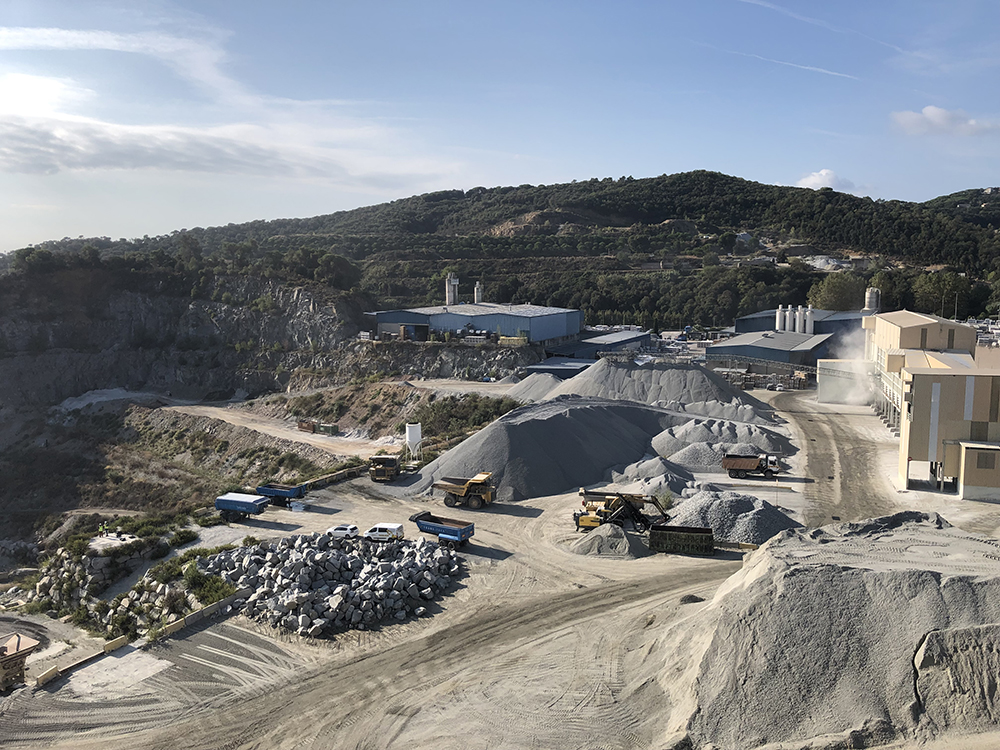
Four Cat wheeled loaders – a 966MXI, 962K, 950H, and a 936E that dates from 1987 - handle the finished products and load external trucks, while a Cat 438 backhoe carries out small work and cleaning tasks.
The new Cat 374 produces 361kW of net power and is the largest excavator operating at the quarry. The new machine’s duties include dropping a 7-tonne iron ball to break up rocks instead of the usual process of blasting them.
In addition to the previous Cat 374, the quarry also operated a Cat 385 until fairly recently which consumed 85 litres of fuel per hour. In comparison the new 374 model, which is a smaller machine than the 385, is able to achieve 32 litres per hour in providing the same levels of materials production.
The site also operates three haulers working eight hours a day – a 32-tonne Cat 769, a Cat 75-tonne 771D and a 35-tonne Komatsu 325HD that was purchased in 2007.
All the Cat equipment at the quarry is supplied by Finanzauto, which is the Cat dealer for Spain and Portugal. Its full line of quarry products includes wheeled loaders, tracked excavators, rigid dump trucks, articulated dump trucks, attachments, as well as generators and other auxiliary machines. It has around 4,400 quarry customers in the Catalonia region, mostly small, family-owned companies.
In terms of what levels of production are likely going forward, Jordi Garcia says this is difficult to predict given uncertainties caused by developments such as the invasion of Ukraine and the state of the domestic market.
“In Spain we are still below the average European levels for buildings and road construction,” he adds. “We are at a low point in the market at present although of course it may increase in future. We are focusing on finding new applications for our products. We look for projects where we can provide specific types of products.”
As part of its sustainability efforts, Àrids Garcia is increasing its activity in the recycling of aggregates.
Jordi Garcia says: “This site is one of the most modern in the Catalonia region. We are always focused on plant automation and are moving towards a point where the whole process – extraction, hauling and processing – will be automatic.”
The company also plans to migrate all the diesel-powered equipment at the quarry to electric power. It aims to install solar panels capable of powering 1,000kW electric vehicles in the first half of 2023, and has the appropriate permits in place to deploy this. The panels will be located in an older part of the quarry that has been prepared for them.

In addition to advanced technology the quarry site also has historical interest, being home to a more than 2,000-year-old Roman observation tower, that is owned by the company and dates from the year 2BC. The building has been restored and can be visited by the public, with the land surrounding it at the back of the quarry being open for cycling and walking. “We try to give something back to the community,” Jordi Garcia says.
Recently the quarry material has been utilised in the construction, repair and expansion of different seaports and in the construction and maintenance of roads and highways. It has also been used in the asphalting of several motor-sport race tracks, including the Circuit de Barcelona-Catalunya – home to the Spanish Grand Prix and Superbike events. Arids Garcia says the results have been highly satisfactory and appreciated by the best drivers at the highest levels of the sport.
Jordi Garcia says the company is characterised by its corporate values, and is “a social enterprise, collaborating with different NGOs and local entities, sensitive to the protection of the environment and the development of equality policies, the promotion of health as well as a good working environment.”
He adds that this environmental commitment, respect for the environment and the biodiversity of the environment has led Àrids Garcia to carry out a range of actions during these years.
“The company has constantly launched environmental initiatives,” he says. “One of the most important solutions adopted to minimise the impact of the quarry activities is the closure of the production plant, reducing dust emissions and noise pollution. Àrids Garcia has promoted the biodiversity development project ‘Si Hay Cantera, Hay Vida’ [If There is a Quarry, There is Life] which stands out.”
The project has focused on the nesting, protection and conservation of rock birds in the quarry extraction area. A quarry landscape is the natural habitat of rock birds which thrive on rocky cuts and cliffs. The air currents caused by the walls of excavated rock facilitate the upward flight of birds of prey as they go for a straight glide in the direction of migration.
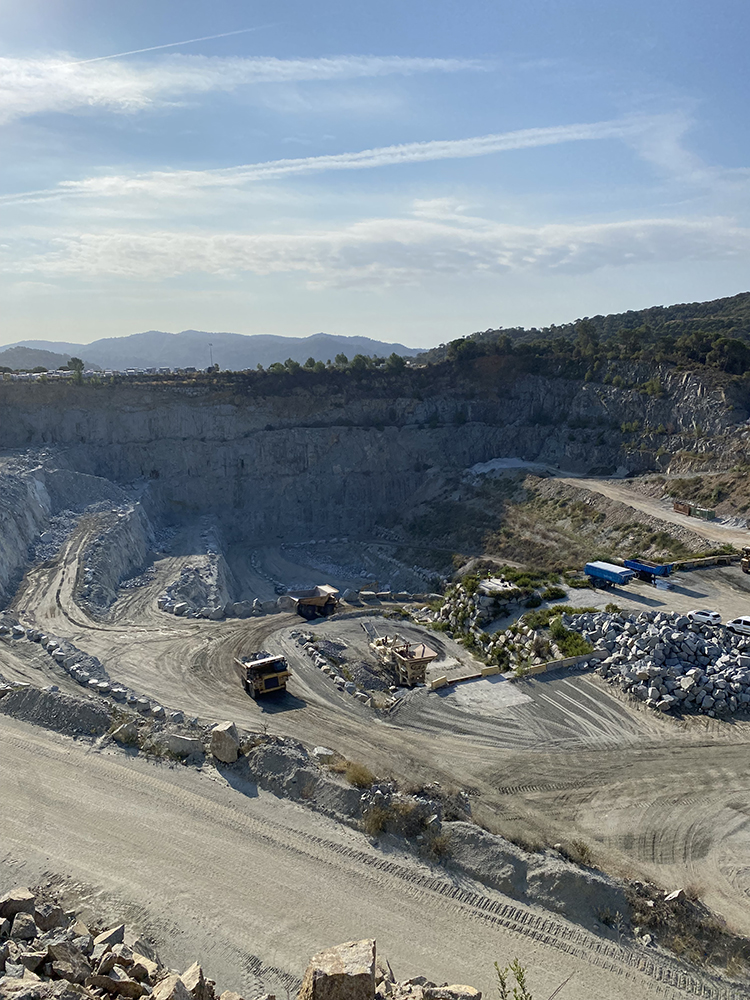
“In 2008, we discovered a pair of nesting Eurasian eagle-owls,” Jordi Garcia says. “It made us realise the importance of protecting the native fauna and we adopted a firm commitment to protect their temporary habitat during the quarry operations. Over the last 15 years we installed different nesting areas to facilitate the right habitat for their reproduction. We installed seven devices to record images, 18 nest boxes and built 5 nests on rocky walls. We saw the birth and growth of 23 Eurasian eagle-owl chicks, 39 common kestrel chicks, 35 blue rock thrush chicks and about 300 Eurasian crag martin chicks as well as a multitude of more common species.”
This ‘Si Hay Cantera, Hay Vida’ project has been recognised in Spain with the first National Prize for Sustainable Development in 2022 and has also been a candidate in European quarrying association UEPG’s awards.
Àrids Garcia says this demonstrates that the extractive industry and nature can perfectly coexist. “Over the last 14 years, biodiversity has been intensively promoted in our quarry,” it adds. “Water points have been built and maintained as drinking troughs for the mammals and to encourage the development of aquatic animals and insects.”
Blasting and activities which could be likely to alter the lifecycle of existing biodiversity have been postponed, and Àrids Garcia has modified the vegetation in the area in order to make it easier for birds of prey to hunt.
The company says it is strongly committed to renewable energies to support the fight against climate change. Àrids Garcia anticipates that its new photovoltaic solar panels will contribute 60% of the total electricity energy necessary for the operation of the treatment plant, and the intention is to grow it in the future to supply 100%.
Additionally, the company’s innovation department is working on equipment automation, emission reduction and recycling. These are key objectives to face the future.
The company used the celebration of its 60th anniversary to renew its corporate image. A modern image has evolved and is focused on the afore-mentioned objectives.
“We are a company with an environmental, social and innovation commitment without forgetting our leitmotiv: ‘Hallmark of quality’,” says Jordi Garcia.

